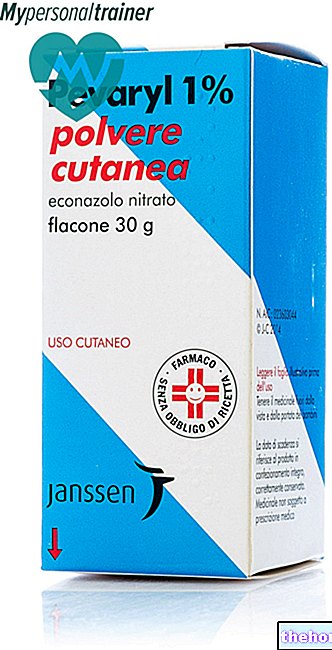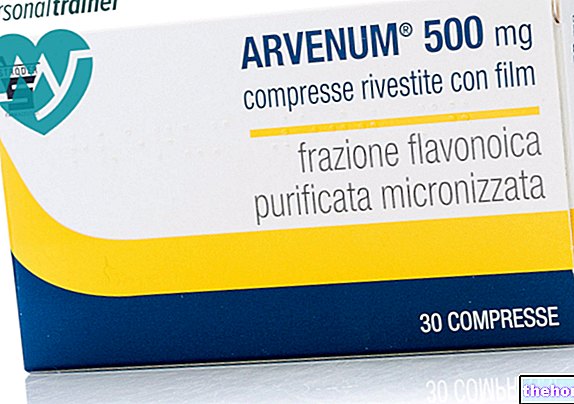Active ingredients: Tizanidine
Navizan Tablets
Source Package Leaflet: AIFA (Italian Medicines Agency). Content published in January 2016. The information present may not be up-to-date.
To have access to the most up-to-date version, it is advisable to access the AIFA (Italian Medicines Agency) website. Disclaimer and useful information.
01.0 NAME OF THE MEDICINAL PRODUCT -
NAVIZAN
02.0 QUALITATIVE AND QUANTITATIVE COMPOSITION -
Each tablet contains 2 mg of tizanidine (as tizanidine hydrochloride)
Each tablet contains 4 mg of tizanidine (as tizanidine hydrochloride)
Excipients with known effects: lactose in the form of anhydrous lactose, 47.21 mg per tablet
Excipients with known effects: lactose in the form of anhydrous lactose, 94.42 mg per tablet
For the full list of excipients, see section 6.1.
03.0 PHARMACEUTICAL FORM -
Tablets.
White to off-white, oval, flat, bevelled edge tablets, debossed with "R179" on one side and halved by a "score on the other side."
White to off-white, oval, flat, bevelled edge tablets, debossed with "R180" on one side and quartered by a "score on the other side.
The score line on the tablet is to facilitate breaking for easier swallowing and not to divide into equal doses.
04.0 CLINICAL INFORMATION -
04.1 Therapeutic indications -
Tizanidine is indicated in adults for the treatment of spastic states associated with multiple sclerosis or spinal injury or disease.
04.2 Posology and method of administration -
Dosage
The effect of tinazidine on spasticity is greatest within 2 to 3 hours after administration and has a relatively short duration of action. The timing and frequency of administration should therefore be individually adapted and tizanidine should be administered in divided doses up to 3-4 times a day, depending on the patient's needs. There is considerable variability in response between patients, therefore careful dose adjustment is required. Care should be taken not to exceed the dose that produces the desired therapeutic effect. Usually a single dose of 2 mg is started and increased in 2 mg increments at intervals of not less than half a week.
The total daily dose should not exceed 36 mg, although it is usually not necessary to exceed 24 mg / day. Secondary pharmacological effects (see section 4.8) may appear at therapeutic doses but can be minimized by slow dose adjustment, so that in the vast majority of patients it is not a limiting factor.
Senior citizens
Experience in the elderly is limited and the use of Tizanidine is not recommended unless the benefit of treatment clearly outweighs the risk. Pharmacokinetic data suggest that renal clearance in the elderly may decrease up to 3-fold.
Patients with renal impairment
In patients with renal insufficiency (creatinine clearance renal function should be monitored adequately.
Patients with hepatic impairment
Tizanidine is contraindicated in patients with significantly impaired hepatic function. Tizanidine should not be used in patients with moderate hepatic impairment unless the potential benefit outweighs the potential risk to the patient. Initiate any treatment with the lowest dose and then increase the dosage carefully and according to the patient's tolerability.
Pediatric population
Experience with tizanidine in patients under the age of 18 is limited. The use of tizanidine is not recommended in children.
Method of administration
Oral administration
04.3 Contraindications -
Hypersensitivity to the active substance or to any of the excipients listed in section 6.1.
The use of tizanidine in patients with significantly impaired hepatic function is contraindicated as tizanidine is extensively metabolised in the liver (see section 5.2).
Concomitant use of tizanidine with potent CYP1A2 inhibitors (such as fluvoxamine or ciprofloxacin) is contraindicated (see sections 4.4 and 4.5).
04.4 Special warnings and appropriate precautions for use -
The concomitant use of tizanidine with CYP1A2 inhibitors is not recommended (see sections 4.3 and 4.5).
Hypotension may occur during treatment with tizandine (see section 4.8) and also as a result of drug interactions with CYP1A2 inhibitors and / or antihypertensive drugs (see section 4.5). Severe manifestations of hypotension such as loss of consciousness and cardiovascular collapse have been observed.
Rebound hypertension and tachycardia have been observed after abrupt discontinuation of tizanidine, when used chronically, and / or at high daily doses and / or in combination with other antihypertensive drugs (see section 4.5). In extreme cases, rebound hypertension can lead to cerebrovascular events. Tizanidine should not be stopped suddenly, but gradually and with regular blood pressure checks.
Kidney failure
Patients with renal insufficiency may require lower dosages and therefore caution should be used when using tizanidine in these patients (see section 4.2).
Liver disorders
Hepatic dysfunction has been reported in association with tizanidine. It is recommended that liver function tests be monitored monthly for the first 4 months of treatment in all patients and in those presenting with clinical symptoms suggesting hepatic dysfunction, such as unexplained nausea, anorexia or fatigue. Treatment with tizanidine should be discontinued if serum levels of serum glutamic pyruvic transaminase (SGPT) and / or serum glutamic oxaloacetia transaminase (SGOT) are consistently above 3 times the maximum normal value.
Pediatric population
Tizanidine must be kept out of the reach and sight of children.
Excipients
Navizan tablets contain lactose. This medicinal product is not recommended in patients with rare hereditary problems of galactose intolerance, severe lactase deficiency or glucose-galactose malabsorption.
04.5 Interactions with other medicinal products and other forms of interaction -
Tizanidine is almost exclusively metabolised by the cytochrome P450 isoenzyme CYP1A2. Co-administration of drugs known to inhibit or induce CYP1A2 activity may increase plasma levels of tizanidine.
Interactions observed that lead to a contraindication
Concomitant use of tizanidine with fluvoxamine or ciprofloxacin, both potent inhibitors of CYP1A2, is contraindicated. Concomitant use of tizanidine with fluvoxamine or ciprofloxacin resulted in a 33-fold and 10-fold increase in the AUC of tizanidine, respectively. clinically significant and prolonged hypotension may cause somnolence, dizziness and decreased psychomotor performance (see sections 4.3 and 4.4).
Interactions observed that do not recommend concomitant use
Co-administration of tizanidine with other CYP1A2 inhibitors such as some antiarrhythmics (amiodarone, mexiletine, propafenone), cimetidine, some fluoroquinolones (enoxacin, norfloxacin,), and ticlopidine, is not recommended (see section 4.4).
Increased plasma levels of tizanidine may lead to overdose symptoms, such as QT prolongation (c) (see section 4.9).
Concomitant use of tizanidine (in high doses) with other products that can prolong QT (c), (eg amitriptyline and azithromycin) is not recommended.
Due to their potential additive hypotensive effects, concomitant use of tizanidine with other alpha-2 adrenergic agonists (such as clonidine) is not recommended.
Oral contraceptives
Pharmacokinetic data following single and multiple doses of tizanidine suggest that the clearance of tizanidine is reduced by approximately 50% in women taking concomitant oral contraceptives.
Although no specific pharmacokinetic study has been conducted to investigate a potential interaction between oral contraceptives and tizanidine, the possibility of a clinical response and / or adverse events to low dose tizanidine should be borne in mind when prescribing tizanidine to a patient who takes contraceptive pills. No clinically significant drug interactions were reported in clinical trials.
Interactions to consider
Rifampicin
Concomitant administration of tizanidine and rifampicin results in a 50% decrease in tizanidine concentrations. Therefore, the therapeutic effect of Tizanidine may be reduced during treatment with rifampicin, an effect which in some patients may be of clinical significance. Long-term concomitant administration should be avoided and, if considered, careful attention may be required. dose adjustment (increase).
Cigarette smoke Exposure to polycyclic aromatic hydrocarbons from cigarette smoke leads to the induction of CYP1A2.
Administration of Tizanidine to male smokers (> 10 cigarettes per day) results in an approximately 30% decrease in systemic exposure to tizanidine. Long-term therapy with Tizanidine in heavy male smokers may require higher doses than average doses.
Antihypertensives
Tizanidine may induce hypotension (see section 4.4) and potentiate the effect of hypotensive drugs, including diuretics. Therefore, caution should be exercised in patients on hypotensive treatment.
Alcohol
During therapy with tizanidine, alcohol consumption should be minimized or avoided as it may increase potential adverse events (e.g. sedation and hypotension). Tizanidine may increase the depressant effect of alcohol on the central nervous system.
Caution should also be exercised when tizanidine is administered with beta-blocking drugs or digoxin, as the combination may potentiate hypotension or bradycardia.
Caution should be exercised in concomitant use of tizanidine with sedative drugs including hypnotics (eg benzodiazepines), antihistamines (eg chlorphenamine) and baclofen due to the possible potentiation of the sedative effect of tizanidine.
04.6 Pregnancy and breastfeeding -
Pregnancy
There are no or limited amount of data on the use of Tizanidine in pregnant women. Studies in animals have shown reproductive toxicity (see section 5.3).
Tizanidine is not recommended during pregnancy and in women of childbearing potential who are not using contraceptives.
Feeding time
Small amounts of tizanidine are excreted in rat milk (see section 5.3). Since a risk to the breast-fed infant cannot be excluded, tizanidine should not be used during breastfeeding.
Fertility
Animal studies have shown no effects on fertility at doses of 10 mg / kg / day and 3 mg / kg / day in male and female rats, respectively (see section 5.3).
04.7 Effects on ability to drive and use machines -
Patients presenting with blurred vision, drowsiness, fatigue or any other symptoms of hypotension should be advised against engaging in activities that require a high degree of alertness such as driving or operating machinery.
04.8 Undesirable effects -
Adverse reactions (Table 1) are listed by frequency, with the most frequent first, according to the following convention: very common (≥1 / 10), common (≥1 / 100 and
1 Hallucinations are self-limiting, with no evidence of psychosis, and have always occurred in patients concurrently taking potentially hallucinogenic drugs such as antidepressants.
2 There have been elevations in hepatic serum transaminases which are reversible upon discontinuation of treatment.
At low doses, somnolence, fatigue, dizziness, dry mouth, decreased blood pressure, nausea, gastrointestinal disorders and increased transaminases have been reported, generally as mild and transient events.
At higher doses, events reported for low doses are more frequent and more pronounced, but rarely severe enough to warrant discontinuation of treatment.
Withdrawal rebound hypertension can lead to cerebrovascular events in severe cases.
Reporting of suspected adverse reactions
Reporting of suspected adverse reactions that occur after authorization of the medicinal product is important, as it allows continuous monitoring of the benefit / risk ratio of the medicinal product.
Healthcare professionals are asked to report any suspected adverse reactions via the national reporting system at www.agenziafarmaco.gov.it/it/responsabili
04.9 Overdose -
Clinical experience is limited. In one case of an adult who ingested 400 mg of tizanidine, recovery was uneventful. The patient was treated with mannitol and furosemide.
Symptoms:
Nausea, vomiting, hypotension, QT prolongation (c), dizziness, miosis, difficulty breathing, coma, restlessness, somnolence.
Treatment.
General supportive measures are indicated and an attempt should be made to remove the ingested substance from the gastrointestinal tract by gastric lavage or activated charcoal. Forced diuresis is expected to accelerate the elimination of tizanidine. Further treatments should be symptomatic. The patient should be well hydrated.
05.0 PHARMACOLOGICAL PROPERTIES -
05.1 "Pharmacodynamic properties -
Pharmacotherapeutic class: centrally acting muscle relaxants, other centrally acting muscle relaxants.
ATC code: M03BX02.
Tizanidine is an alpha2-adrenergic receptor agonist in the central nervous system at the supra-spinal and spinal levels. This affect determines an "inhibition of" reflex polysynaptic spinal activity. Tizanidine has no direct effect on skeletal muscles, neuromuscular junctions or spinal monosynaptic reflexes.
In humans, tizanidine reduces pathologically increased muscle tone, including resistance to passive movement, and relieves painful spasms and clones.
05.2 "Pharmacokinetic properties -
Absorption and distribution
Tizanidine is rapidly absorbed, reaching peak plasma concentrations in approximately 1 hour. Tizanidine is only 30% bound to plasma proteins and has been shown to easily cross the blood-brain barrier in animal studies. The mean steady-state volume of distribution (Vss) following i.v. is 2.6 L / kg (CV 21%). Although tizanidine is readily absorbed, first pass metabolism limits bioavailability to 34% of an intravenous dose. The maximum plasma concentration (Cmax) of tizanidine is 12.3 ng / mL (coefficient of variation, CV, 56%) and 15.6 ng / mL (CV 60%) after single and repeated 4 mg administration, respectively.
Concomitant ingestion of food has no influence on the pharmacokinetic profile of tizanidine tablets (administered as 4 mg tablets). Although the Cmax value is approximately 1/3 higher after administration of the tablet under fed conditions, it does not it is considered to be of clinical relevance, just as the effect on the extent of absorption (AUC) is not significant.
Biotransformation and elimination
Tizanidine is metabolised rapidly and to a large extent (approximately 95%) in the liver and the pattern of biotransformation in animals and humans is qualitatively similar. Tizanidine, in vitro, is mainly metabolised by cytochrome p450 1A2. The metabolites are excreted mainly by renal route (approximately 70% of the administered dose and appear to be practically inactive). Renal excretion (determined by the percentage recovery in urine of the total amount of radioactivity administered) is approximately 53% after a single 5 mg dose and 66% after the administration of 4 mg three times a day. The half-life of tizanidine from plasma is 2-4 hours.
Linearity / non-linearity
Tizanidine has linear pharmacokinetics over the dose range of 1 to 20 mg.
Characteristics in particular patient populations
Patients with renal impairment
In patients with severe renal impairment (creatinine clearance
Patients with hepatic impairment
No specific studies have been conducted in this population. Since tizanidine is extensively metabolised in the liver by the CYP1A2 enzyme, hepatic impairment may increase its systemic exposure. Tizanidine is contraindicated in patients with severe hepatic impairment (see section 4.3).
Elderly population
Pharmacokinetic data in this population are limited.
Gender and ethnicity
Gender has no clinically significant effect on the pharmacokinetics of tizanidine. The impact of ethnic sensitivity and race on the pharmacokinetics of tizanidine has not been studied.
05.3 Preclinical safety data -
Acute toxicity
Tizanidine possesses a low level of acute toxicity. Signs of overdose have been observed after single doses> 40 mg / kg in animals and are related to the pharmacological action of the medicinal product.
Repeated dose toxicity
The toxic effects of tizanidine are mainly due to its pharmacological action. At doses of 24 and 40 mg / kg / day in sub-chronic studies in rodents, the alpha 2-agonist effect leads to central nervous system stimulation, eg motor excitation, aggression, tremor and convulsions.
Signs related to centrally mediated muscle relaxation, eg. sedation and ataxia were frequently observed at lower dose levels in sub-chronic and chronic oral toxicity studies in dogs. These signs, related to the drug's myotonolytic activity, were observed at doses of 1- 4 mg / kg / day in a 13-week dog study and 1.5 mg / kg / day in a 52-week study in the dog.
QT interval prolongation and bradycardia were observed in chronic toxicity studies in dogs at doses of 1.0 mg / kg / day and above.
Slight elevations in serum transaminases have been observed in several toxicity studies at the higher dose levels. These were not always associated with histopathological changes in the liver.
Mutagenesis
Various tests in vitro and in vivo, did not produce evidence of a mutagenic potential of tizanidine.
Carcinogenesis
No evidence of carcinogenicity was demonstrated in two long-term studies in mice (78 weeks) and rat (104 weeks) at dose levels up to 9 mg / kg / day in the rat and up to 16 mg / kg / day in the rat. mouse. At these dose levels, corresponding to the maximum tolerated dose, on the basis of the reduction in development speed, no neoplastic or pre-neoplastic pathologies attributable to the treatment were observed.
Reproductive toxicity
Reproduction studies conducted in rats at a dose of 3 mg / kg / day and in rabbits at a dose of 30 mg / kg / day of tizanidine, showed no evidence of teratogenicity. Doses of 10 and 30 mg / kg / day increased gestation duration and dystocia in female rats. An increase in fetal and pup loss was observed and developmental delay occurred (evidenced by decreased fetal body weight and delayed ossification of the skeleton). At these doses, the mothers showed marked signs of muscle relaxation and sedation.
No reduction in fertility was observed in male rats at a dose of 10 mg / kg / day and in female rats at a dose of 3 mg / kg / day. Fertility was reduced in male rats treated with 30 mg / kg / day (totally reversible after a recovery period of 2 weeks) and in female rats with 10 mg / kg / day. At these doses, maternal behavioral effects and clinical signs including marked sedation, weight loss, and ataxia were observed.
Tizanidine and / or its metabolites are known to pass into the milk of rodents.
06.0 PHARMACEUTICAL INFORMATION -
06.1 Excipients -
Anhydrous lactose,
microcrystalline cellulose,
anhydrous colloidal silica, stearic acid.
06.2 Incompatibility "-
Not applicable.
06.3 Period of validity "-
3 years.
06.4 Special precautions for storage -
Do not store at temperatures above 30 ° C.
06.5 Nature of the immediate packaging and contents of the package -
PVC / PVdC - Aluminum blisters.
Blister packs of 15, 20, 30, 100 and 120 tablets.
Not all pack sizes may be marketed
06.6 Instructions for use and handling -
No special instructions.
07.0 HOLDER OF THE "MARKETING AUTHORIZATION" -
I.B.N SAVIO S.R.L, Via del Mare 36
00071 Pomezia
Rome
Dealer for sale :
Itapharma Srl - Via Ponte a Piglieri n. 8, 56121 Pisa
08.0 MARKETING AUTHORIZATION NUMBER -
"2 mg Tablets" 15 Tablets in blister Pvc / Pvdc / Al AIC n. 039422011
"2 mg Tablets" 20 Tablets in blister Pvc / Pvdc / Al AIC n. 039422023
"2 mg Tablets" 30 Tablets in blister Pvc / Pvdc / Al AIC n. 039422035
"2 mg Tablets" 100 Tablets in blister Pvc / Pvdc / Al AIC n. 039422047
"2 mg Tablets" 120 Tablets in blister Pvc / Pvdc / Al AIC n. 039422050
"4 mg Tablets" 15 Tablets in blister Pvc / Pvdc / Al AIC n. 039422062
"4 mg Tablets" 20 Tablets in blister Pvc / Pvdc / Al AIC n. 039422074
"4 mg Tablets" 30 Tablets in blister Pvc / Pvdc / Al AIC n. 039422086
"4 mg Tablets" 100 Tablets in blister Pvc / Pvdc / Al AIC n. 039422098
"4 mg Tablets" 120 Tablets in blister Pvc / Pvdc / Al AIC n. 039422100
09.0 DATE OF FIRST AUTHORIZATION OR RENEWAL OF THE AUTHORIZATION -
05/03/2010




























